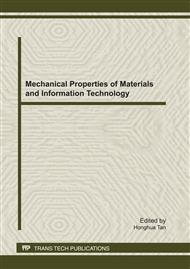[1]
Z. Zhang and R. S. Blum, A categorization of multiscale decomposition based image fusion schemes with a performance study for a digital camera application, in Proc. Of the IEEE 1999, p.1315.
DOI: 10.1109/5.775414
Google Scholar
[2]
X. B. Qu, and J. W. Yan, Multi-focus image fusion algorithm based on regional firing characteristic of pulse coupled neural networks, in Proc. Of ICBC 2007, pp.62-66.
DOI: 10.1109/bicta.2007.4806419
Google Scholar
[3]
M. Li, W. Cai, Z. Tan, et al, Pulse coupled neural network based image fusion. Advances in neural networks, Lecture Notes in Computer Science, vol. 3497, pp.741-746, (2005).
DOI: 10.1007/11427445_119
Google Scholar
[4]
W. Li and X.F. Zhu, A new algorithm of multi-modality medical image fusion based on pulse coupled neural networks, , Lecture Notes in computer Science, vol. 3610, pp.995-1001, (2005).
DOI: 10.1007/11539087_131
Google Scholar
[5]
X. B. Qu, C. W. Hu, and J. W. Yan, Image fusion algorithm based on orientation information motivated pulse coupled neural networks, in Proc. Of the seventh World Congress on Intelligent control and automation-WCICA, 08, p.2437.
DOI: 10.1109/wcica.2008.4593305
Google Scholar
[6]
M. I. Chacon, A. Zimmerman, and P. Rivas, Image processing applications with a PCNN, Advance in Neural networks-Isnn 2007, Pt 3, Proceedings, vol. 4493, pp.884-893, (2007).
DOI: 10.1007/978-3-540-72395-0_109
Google Scholar
[7]
G. Kuntimad, and H. S. Ranganath, Perfect image segmentation using pulse coupled neural networks, IEEE Transactions on Neural Networks, vol. 10, no. 3, pp.591-598, (1999).
DOI: 10.1109/72.761716
Google Scholar
[8]
R. Q. Mao and X. L. Gong, Image fusion algorithm based on arbitrary shaped regions combination, International Conference on Intelligent Control and information Processing 2010, pp.120-123.
DOI: 10.1109/icicip.2010.5564199
Google Scholar
[9]
H. Chen, J. Zhu, Y. Y. Liu et al, Image fusion based on pulse coupled neural network, J. of Optics and Precision Engineering, Vol. 18(40), pp.996-999.
Google Scholar
[10]
I. S. Moria, P. H. Jamie, Review of image fusion technology in 2005, J. SPIE, p.5782, (2005).
Google Scholar
[11]
R. X. YU, B. Zhu and K. Zhang, New image fusion algorithm based on PCNN, J. optics electronic engineering, vol. 35(1), pp.126-130, (2008).
Google Scholar
[12]
G. X. Liu and X. H. Lin, Image fusion fast algorithm based on CMAC, J. Opt. Precision Eng., vol. 16(5), pp.2045-2049, (2008).
Google Scholar


